GATUNDU KENYA- REPORT 2018
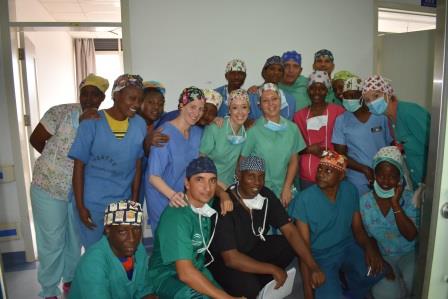
Gatundu is a small village of about 20.000 inhabitants in the province of Kiambu, an hour by car from Nairobi, which is famous for being the birthplace of Kenya’s first president (JomoKenyata) and of the actual president, UhuruKenyata, his son. Even though there are many religions known there, the Catholic one is the main one. The city’s infrastructures are primitive, without asphalt on the streets, and with a population that lives on a rent of15 per person and day. Rice, vegetables and other products of the field are the basis of the economy and the fare in Gatundu.
Preparation for the mission
The Gatundu campaign 10/2018 was organized according to the administrative authority of the “IV Gatundu Hospital” (Dr. Gitau) in the period of two weeks between September 28 and October 12 in 2018, with a total of 10 days for surgical activities which were carried out on 3 surgical tables simultaneously (one for children and two for adults). With a view to operate upon 6 patients per operation theatre and session we formed we formed a team of 10 from the “Cirujanos en Acción” Foundation (one pediatric surgeon Dr. Morán, three general surgeons, Dr. Ramirez, Dr. Fajardo and Dr. Sanchez-Relinque, two anaestesists, Dr. González and Dr. Agullló, one family doctor, Dr. Sabater, and three nurses Mr Gomez, Missis Gall.) We offered to extend our operations to include goiter).
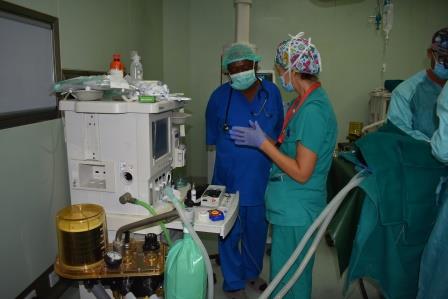
Two weeks before the beginning of the campaign we were told by the hospital administrative authority that we would operate for five days, while we had dedicated much time and effort for three months. Finally the intercession of Dr. Teresa Butrón extended the period to 7 days, but only to operate on two tables simultaneously (a third one being ready in case of great need); we were also told that they had been able to get 85 patients in all, not more.
We have carried out the protocol visits to External Health in the respective provinces, strictly following the rules for vaccination and profilaxis required in a visit to Kenya. We got our visas contacting by mail the embassy to receive them by registered mail which is better in practice than the electronic visa.
The journey
The journey to Gatundu begun with our two groups starting on the morning of Friday 28 December, one group from Málaga (stopping at Estambul and arriving in Nairobi at 2.15 a.m. on 29th September) and another starting from Madrid (with stop in El Cairo and arriving in Nairobi at 3.45 a.m. on 29th September.) Due to a delay of more than 1 hour in the starting of the Málaga-Estambul flight, the Málaga group lost the connection to Nairobi and had to remain 24 hours in Estambul, arriving in Nairobi on the morning of September 30. The meeting of the whole group took place on the morning of Sunday 30 September at breakfast time. For 6 members of the team this was the first “Cirujanos en Acción” campaign.
We had 480 Kg of medical and surgical material to take to Gatundu, 400 from Málaga and 80 from Madrid. In Málaga we had serious problems when registering at the Turkish Airlines desk, as the person in charge absolutely refused to cooperate (while the land people were charming). We had to leave 65 Kg of material in the airport ad they wanted us to pay 2900 extra euros for extra luggage. This lack of cooperation on the part of Turkish Airlines is so glaring in contrast with other airlines that I think we should try new strategies to avoid that trouble in the future, as the behavior of the airlines does not fit with our preference for the most deprived people.
The arrival in such places always implies some kind of conflict as the sensibility of Air Companies does not fit at all with the commitment of our Foundation to work for the poorer people.
The arrival in these places always implies some trouble in customs, so that it will be convenient to get some kind of help to accelerate matters. No kind of communication was established in spite of all our efforts. We found help in the document the Kenya ambassador in Spain gave us and in which he indicated the in an official document our presence there and all the material we carried with us. I want to record my thanks to the ambassador Bramwe Waiaula and to Mr. Javier Gomez, member in the Kenya embassy, for their help in all moments.
Even so, and in spite of all documents you can show them, they will always try to show that some papers are missing and that we had to pay customs taxes. We have to stand firm, to insist that we are coming to help the people and that we do not need any more documents.
STAYING PLACES AND TRANSPORTATION
We are staying at the Maxland Hotel, half an hour by car from Nairobi and about 20 minutes from the Gatundu Hospital. It is a fine hotel, clean and with a good image, equivalent to a 3-4 star in Spain. It has a very clean and large swimming pool ready for use, the rooms are cleaned daily, the beds have mosquito nets and the baths are very decent. It has wifi that works very well in the common zones (hall and dining room) and not so well in the rooms. Every morning they gave us breakfast at 6.30 a.m. with bread and the possibility of fruit, cereals, black beans, bacon and scrambled eggs, and you could also take an omelet prepared with the ingredients you wanted. Next to the hotel is a shopping centre with a great supermarket in which you can buy anything at a good price, and where we went daily (it closed at 10 p.m.) for whatever we needed. Every night the members of the team met in the hotel dining room for dinner with the team members, as there were no places to walk and no other eating options to choose. Dining out in Nairobi is only advisable if you are ready to put up with two hours to go and two to come back in terrible traffic, as we did on Saturday 6th October as a farewell. The hotel price including breakfast about 35 american dollars, and it can be paid in that money or in KSH, the local Kenya money equivalent to 0.015 (so that 100 KSH make one dollar).
Transport from the airport to the Maxland and back both ways to the hotel to the Gatundu hospital took place in a 12 places jeep supplied free by the Hospital. I can only say that the driver, Cyrus, is a serious person, that he drives very well and he has given us much safety in spite of the traffic being horrible in that zone of the country, constantly through roads without asphalt, without traffic lights, and with cars and motorcycles overcharged and often on the wrong side.
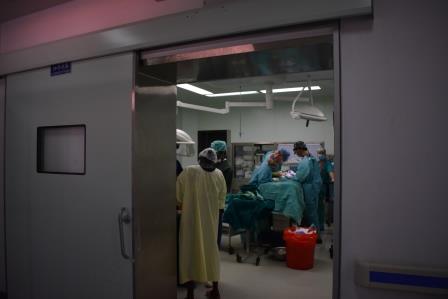
THE HOSPITAL
“Level IV Gatundu Hospital” is a hospital recently built (2013) with the help of 11 million dollars by the Chinese government (all the notices in the hospital are in English and Chinese) which helps the old hospital actually in partial use. The new bloc has 5 heights, a low one for urgencies and admissions, two por hospitalization with six rooms with eight beds each, occupied by our operated patients (even so with an occupation not above 50 percent) and two zones of operation theaters, one of gynecology in the second story and another in the third one with two operation theaters (“Theaters 3 & 4) in which we had worked daily. The operations theaters are roomy and relatively new, although they lack much material as could be expected; the lights of operation theater 3 have not worked in the hole week, and operations have been possible thanks to the use of photophores which I recommend to bring always with us. There are two respirators that work very well and a Valleylab electric scalpel which works well. In the other operation theatre we have worked with the electric scalpel we always carry with us.
The recuperation room is very rudimentary, it was empty and we kept there patients been observed for a while after operation by some nurse in the hospital till they could be sent to a room. The operation room area has also a little room in which we have kept our material, and a place for the staff in which they daily sent us our half-morning breakfast with tea, coffeeand greens, and a lunch with rice and greens. They also brought us bottled mineral water. For sterility we had an autoclave which worked by heat (there are no gas systems) and which gave us trouble only one day when the whole village was left without supply and we were left without any water. We had taken with us three boxes of specific material for hernias, although the hospital has a number of boxes full of passable surgical material but without any order. There were no right angle dissectors in any box, and most of the Kocher pincers had no grasp at all.
The staff in the operation theatre and other helpers was excellent and very dedicated, whether the chiefs (David Karuga and Weru Kennedy) or the helpers and students that helped us. I want to mention particularly the lady doctor responsible for the coordination of doctors and patients, Victoria Kithinji (Vicky for us) who showed a great human value, professionalism, availability and capacity to communicate with our team.
SURGICAL ACTIVITY

During the 7 days of surgical activity in the Gatundu Hospital we worked on patients selected by local doctors and listed day to day by them. We also worked on some surgical cases that came to the hospital, given the scarcity of surgeons. On the whole we worked on 82 patients (42 adults and 40 children) with 104 surgeries divided as follows:
ADULTS: 17 inguinal hernioplasties (7 Rutkow-Robbhins& 10 Lichtenstein); 3 umbilical hernioplastics; 15 total tiroidectomies; 3 traumatic wounds; 2 Hiatic hernias (Nissen); 2 hiatic hernias (Nissen); 2 hidrocelectomies; 2 queloidal surgeries in the auricular pavilion; 1 eventration; 1 fimosis; 1 over infected fascitis;1 autologos skin insertion; 1 giant testicular tumor of germital stock; and 1 pediunculated wart.
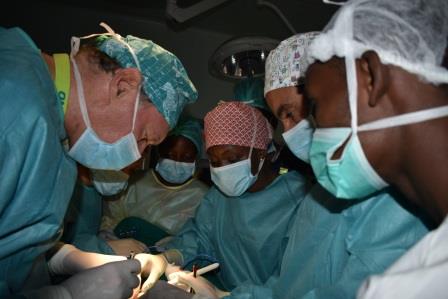
CHILDREN: 16 umbilical hernias; 14 criptorquidial; 10 inguinal hernias; 6 hidrocels; 3 fimosis; 1 hipopasdias; and 1 case of non differenciated genitals.
We have had only 2 post-operative complications, a minor one (inguinal post-operative) and a mayor one(disnea and larynx ‘estridor’ which was treated with a temporal traqueostomy). A week after coming back to Spain I personally contacted the patient and lady doctor Kithinji who informed me that an indirect laryngostomy had been made in which can already be observed a proper performance of the vocal cords so that we can expect that the patient will be decanulated in the following weeks. All patients, except the one mentioned above, were dismissed the next day and no complications have reported. Even today we are in daily contact with lady doctor Kithinji to solve all her doubts in the follow up and revisions of the patients operated upon.

TEACHING ACTIVITY
On the first day we received the visit of Dr. Gitau who proposed to have an activity with the CME (Continued Medical Education). It was an excellent idea and we fixed Thursday 4th October at 8 a.m. The presentation was a success with a great interest on the part of the young internal doctors of the hospital. The place was full for an activity that took 60 minutes with contributions from lady doctor Fajardo (“Basic concepts of inguinal hernia and its treatment), Dr. Morán (Timetable for children paediatric surgery) and Dr. Ramírez (“Options for surgical treatment in the multinodular goiter”.
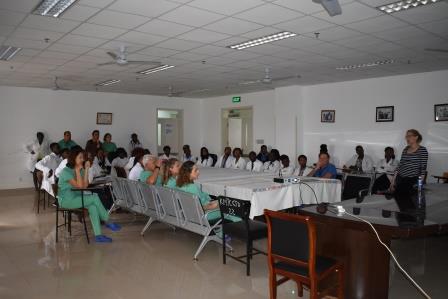
EXPENSES
All the expenses of the campaign were contributed by the ten volunteers, and they divide as follows:
Journey (by plane both ways): 4627 euros
Maxland Hotel: 4150 euros (45 euros for person and night)
Meals and transportation: 15 euros for person and day (1350 euros)
Instruments afforded: 825 euros.
From the point of view of patients operated and hours spent we can say that the aim of the mission has been accomplished.

From the point of view of the organization, once we arrived in Kenya everything went well: hotel reservations, transport, operation theater and collaboration on the part of the Hospital staff.
I think that to organize such a mission it is essential to have a direct and clear communication between the leader of the same and the local collaborates of the Hospital in order to define the type of pathology and the way of working (essentially the number of working days, the number of operation theaters available and the number of patients). I believe this aspect can definitely be improved because we have planned a human team and the medical and surgical material that has overvalued the expectative of the work to be carried out. I ask the local coordinators to improve this aspect in future missions.
Finally the fact that in 7 days were operated only 23 hernias in adults leaves me with mixed feelings. It is true that we have operated for very complex and exacting cases, but very few patients were recruited for hernia in a campaign run by “Hernia International” and “Surgeons in Action”.
While saying that some points could be improved I am delighted to say that I would come again to Gatundu in order to help the people there.

